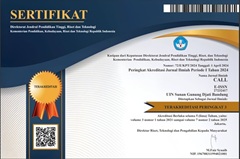The Construction of Meaning and Position of Mental Disorder Character in Three Romance Films
DOI:
https://doi.org/10.15575/call.v2i2.9342Abstract
This research discusses the representation and discourse which focused on the elements of characterization and narration which is presented by mental disorder character in Silver Linings Playbook (2012), Touched with Fire (2015), and The Other Half (2016). In this research, mental illness is not analyzed as a medical narration but also is one of signifying practices. The approaches of media representation analysis from Simon Cross (2014) and Harper (2008) are used to determine the representation of life experiences and disassemble the emerging discourses. The result indicates that when mental illness is represented in the romantic film, the stereotype about abnormality, rejection, and exclusion still becomes the main structure of the narrative. The romance story that wraps it up still refers to the stereotype. Therefore, those three films can be concluded as a part of dominant statements on abnormality discourse against mental disorder sufferers. In this case, mental disorder sufferers are subjected as a subject that must change. It is because only one choice for mental disorder sufferers to be accepted in society, that is recovery.
Keywords: Mental Disorder Character, Discourse, Representation, Film
References
Book
Abrams, M. H., & Harpham, G. G. (1999). A Glossary of Literary Terms 7th Edition.
Barthes, R. (1968). Elements of semiology. Macmillan.
Barthes, R. (2015). Mythologies. Le Seuil.
Chandler, D. (2017). Semiotics: the basics. Taylor & Francis.
Coleborne, C. (2020). Why Talk about Madness?: Bringing History Into the Conversation.
Springer Nature.
Foucault, M. (2013). Archaeology of knowledge . Hoboken.
Foucault, M. (1979). Discipline and punish [1975]. na.
Foucault, M. (1988). Madness and civilization: A history of insanity in the age of reason. Vintage.
Highmore, B. (2016). Culture, Routledge.
Jamison, K. R. (1996). Touched with fire. Simon and Schuster.
Notosoedirdjo, M., & Latipun. (1999). Kesehatan mental: konsep dan penerapan. UPT Penerbitan Universitas Muhammadiyah Malang.
Mills, S. (2003). Routledge Critical Thinkers: Michel Foucault. London: Rouledge.
Saukko, P. (2003). Doing research in cultural studies: An introduction to classical and new methodological approaches. Sage.
Williams, R. (1983). Culture and society, 1780-1950. Columbia University Press.
Journal Article
Cross, S. (2004). Visualizing madness: Mental illness and public representation. Television & New Media, 5(3), 197-216.
Foucault, M. (1982). The subject and power. Critical inquiry, 8(4), 777-795.
Hall, S. (1997). The work of representation. Representation: Cultural representations and signifying practices, 2, 13-74.
Harper, S. (2008). Understanding mental distress in film and media: a new agenda?. The journal of the Royal Society for the Promotion of Health, 128(4), 170-174.
Internet Sources
Cambridge (n.d). Other Half. In dictionary.cambridge.org dictionary. Retrieved July 18, 2020, from https://dictionary.cambridge.org/dictionary/english/other-half
Merriam-Webster. (n.d.). Playbook. In Merriam-Webster.com dictionary. Retrieved July 15, 2020, from https://www.merriam-webster.com/dictionary/playbook
Merriam-Webster. (n.d.). Silver lining. In Merriam-Webster.com dictionary. Retrieved July 15, 2020, from https://www.merriam-webster.com/dictionary/silver%20lining
Downloads
Published
Issue
Section
Citation Check
License
Authors who publish in CALL agree to the following terms:
- Authors retain copyright and grant the journal right of first publication with the work simultaneously licensed under Attribution-ShareAlike 4.0 International (CC BY-SA 4.0) License that allows others to share the work with an acknowledgment of the work's authorship and initial publication in this journal.
- Authors are able to enter into separate, additional contractual arrangements for the non-exclusive distribution of the journal's published version of the work (e.g., post it to an institutional repository or publish it in a book), with an acknowledgment of its initial publication in this journal.
- Authors are permitted and encouraged to post their work online (e.g., in institutional repositories or on their website) prior to and during the submission process, as it can lead to productive exchanges, as well as earlier and greater citation of published work (See The Effect of Open Access).




